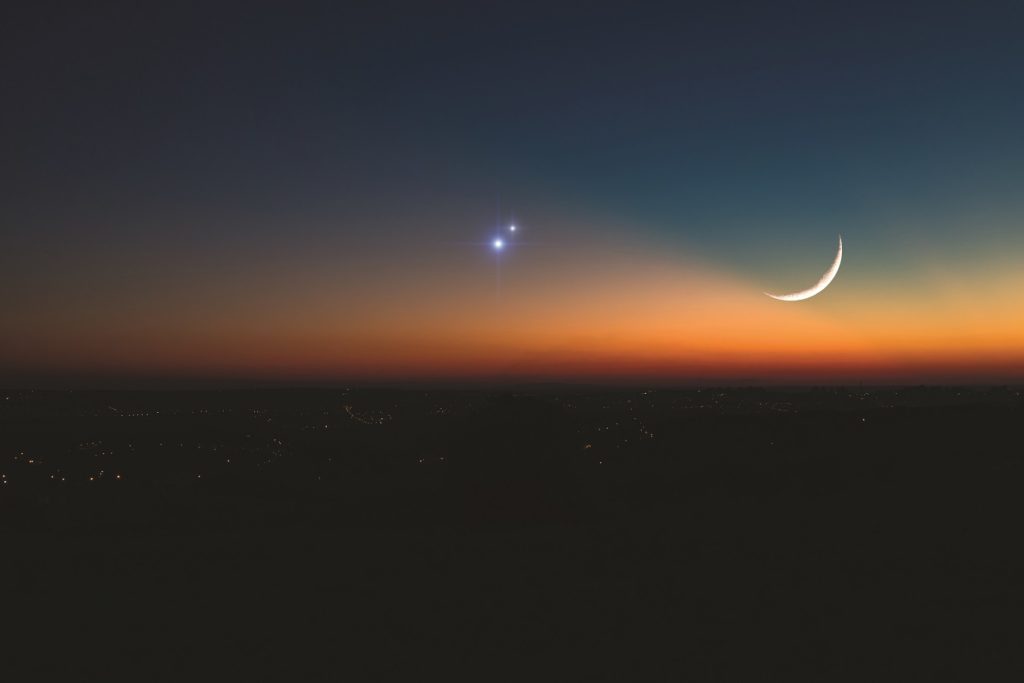Astronomy rewards early risers. In the chilly hour before sunrise, darkness gives way to ghostly yellow along the eastern horizon. Look a little higher and the sky is blue. Straight overhead it’s a deep dark blue, while in the west night lingers, and the stars still shine.
But keep your gaze turned towards the east. When Earth’s orbit aligns just so with the orbits of other planets, you may see one or more of them there, glittering brightly against an otherwise empty canvas of pale sky: red Mars, blue-white Venus, golden Saturn, or maybe white-gold Jupiter. They may be joined by one or two of the very brightest stars, or even a lovely crescent Moon that seems to touch them. And when the alignments are even more serendipitous, these brilliant gems can appear close together, an especially pretty spectacle called conjunction.
These events can also occur in the west at evening twilight, and I admit that observing the sky just after sunset is much easier than just before sunrise. But I enjoy early morning events more. It is quieter. And because I’m sky-watching now in my city neighborhood, that means few cars are on the roads. No one is out with their dogs yet. No leaf blowers, no music playing, no other voices. The world holds its breath, while the planets have the stage to themselves in a brightening sky free of the dimmer stars.
The show is better in a way for its brevity. All too soon the Sun climbs above the horizon, flooding the world with light and life and noise, and the planets vanish.
This April promises some remarkable early morning events, as several orbits come into fortuitous alignment. And if you’re able to observe more than once this month, you’ll witness the clockwork progression of orbits and alignments as the positions of the various objects change almost morning to morning. At dawn on April 1, Mars, Saturn, and Venus were close together in the east-southeast. A few days later, Saturn and Mars appeared very close to each other at ½ degrees apart, or one full Moon-width.

Looking ahead, April 18 is the pièce de resistance: 45 minutes before sunrise you’ll see Jupiter, Venus, Mars, and Saturn evenly spaced along a rising line from low in the east to higher in the southeast. If you set your alarm early only once during this month, this is the morning to do it — it’s a good idea to check the weather forecast the night before.
If the weather or will power let you down, don’t worry. There’s still more to see. On April 22, the Lyrid annual meteor shower peaks. You can expect 10 to 15 meteors per hour with the Lyrids, which often leave a long trail of ionized gas that lingers for several seconds. This year the waning Moon will obscure the dimmer meteors, diminishing the show somewhat. But it’s still worth the effort to go out and watch if the sky is clear. The morning of April 23 should also be a good time to watch for them.
On April 25, the crescent Moon, Saturn, and Mars form a neat triangle in the southeast, while Venus and Jupiter pair off in the east. And on April 30 at dawn, the two most dazzling planets, Jupiter and Venus, rise together in the east very close together.
For those who just can’t rise early, there are always some consolation prizes in the evening. On April 29, you can catch sight of the ever-elusive planet Mercury close to the Pleiades. They will be low in the west, so you’ll have a very short time after the sun sets to find them before they also sink below the horizon. The Seven Sisters are fairly easy to locate if you familiarize yourself with their appearance beforehand (search the internet for images of Pleiades and look for images similar to what the unaided eye would see, rather than Hubble-type images). Mercury will be a pink-white star, not particularly bright, and close beside them on the left.
Action-packed months like this April are unusual; I hope you’re able to get out there and experience it for yourself. Clear skies!



